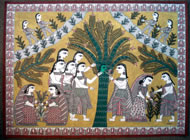As yet another example of the desperate ‘science’ of Monsanto, it is now being argued that genetically engineered Bt cotton – introduced in India in 1997 – has liberated Indian women. In a paper authored by Arjunan Subramanian, Kerry Kirwan, David Pink and Matin Qaim, the argument is that the crop produces massive gains for women’s employment in India.
But this argument is false on many grounds.
Firstly, women have traditionally been seed keepers and seed breeders, which means that the knowledge and skills related to seed conservation and seed breeding have been women’s expertise. The seed economy was a women’s economy. As long as seed was in women’s hands, there was no debt and there were no suicides. Women have acted as custodians of the common genetic heritage through the shortage and preservation of grain.
In a study of rural women of Nepal, it was found that seed selection is primarily a female responsibility. In some 60% of cases, women alone decided what type of seed to use. As to who actually performs the task of seed selection, in cases where the family decides to use their own seeds, this work is done by women alone in more than 80% of the households, by both sexes in 8% and by men alone in only 10%.
Throughout India, even in years of scarcity, grain for seed was conserved in every household, so that the cycle of food production was not interrupted. The peasant women of India have carefully maintained the genetic base of food production over thousands of years. This common wealth, which has evolved over millennia, has been defined as ‘primitive cultivars’ by the masculinist view of seeds, which sees its own new products as ‘advanced’ varieties.
The replacement of traditional varieties of seeds with genetically engineered Bt cotton is an appropriation of women’s skills, knowledge and decision-making. This is disempowerment of women, not empowerment. Moreover, women have always played a significant role in agriculture: most farmers in India are women.
The replacement of biodiverse cropping systems evolved by women with monocultures of Bt cotton leads to a decline in food production. This undermines women’s food sovereignty and erodes food security, which in women’s hands is women’s empowerment. Further, it destroys women’s work relating to agricultural production and post-harvest food processing. Interestingly women’s work in relation to food sovereignty has been defined as ‘femimanual’ work.
The growing of food is the most important source of livelihood for the majority of the world’s people, especially women. It is also the most fundamental economic right. Women were the world’s original food producers, and they continue to be central to food-production systems in the Third World in terms of the work they do in the food chain.
The worldwide destruction of feminine knowledge of agriculture, evolved over four to five thousand years, by a handful of white male scientists in less than two decades has not merely violated women as experts, but gone hand in hand with the ecological destruction of Nature’s processes and the economic destruction of poorer people in rural areas.
Agriculture has been evolved by women. Most of the world’s farmers are women, and most girls are future farmers. Girls learn the skills and knowledge of farming in the fields and farms. What is grown on farms determines whose livelihoods are secured, what is eaten, how much is eaten, and by whom it is eaten.
Women make the most significant contribution to food security. They produce more than half the world’s food. They provide more than 80% of the food needs of food-insecure households and regions. Food security is therefore directly linked to women’s food-producing capacity. From field to kitchen, from seed to food, women’s strength is diversity, and their capacities are eroded when this diversity is eroded.
In India, cotton was not traditionally grown as a monoculture: it was grown with sorghum and pigeon peas and chillies. The knowledge of these biodiverse systems was women’s knowledge – a knowledge that has declined as a result of the introduction of Bt cotton. But it is a decline that is perversely hidden. The monoculture of the mind, focusing only on Bt cotton, falsely projects women’s dependence on cotton-picking as an increase in employment and empowerment.
The FAO reports that women use more plant diversity, both cultivated and uncultivated, than agricultural scientists know about. In Nigerian home gardens, women plant up to 57 different plant species. In sub-Saharan Africa, women cultivate as many as 120 different plants. In Guatemala, home gardens of less than 0.1ha have more than ten tree and crop species.
In a single African home garden, more than 60 species of food-producing trees have been counted. In Thailand, researchers found 230 plant species in home gardens. In Indian agriculture, women use 150 different species of plants for vegetables, fodder and health care. In West Bengal, 124 ‘weed’ species collected from rice fields have economic importance for farmers. In Mexico, peasants utilise more than 430 wild plant and animal species, of which 229 are eaten.
Women are the biodiversity experts of the world.
Women’s work in cotton-picking (which Monsanto projects as an increase in absolute terms) has increased because monocultures have replaced mixed cultivation of cotton with food crops. The increase in cotton is because of the replacement of biodiverse farming with cotton monocultures, and the expansion of acreage under cotton. It is not because of higher yields of Bt cotton.
The introduction of the Bt gene into crops is not a yield-increasing technology. It is a toxin-producing technology. In addition, even though Bt cotton is supposed to control pests, the bollworm has become resistant and new pests have emerged. Now cotton farmers are using 13 times more pesticides than they did for conventional cotton. High costs of seeds and pesticides lead to debt and debt leads to suicides – creating Bt cotton widows, not liberated ‘housewives’.








